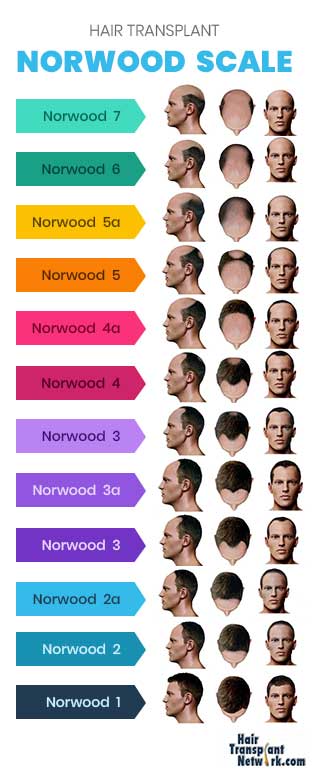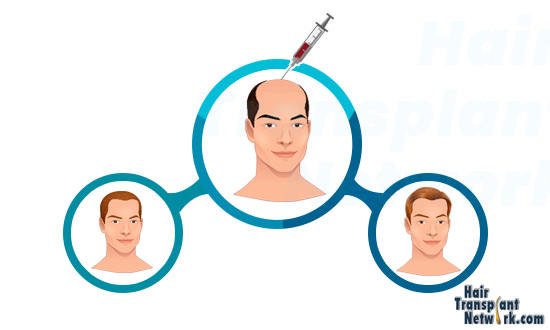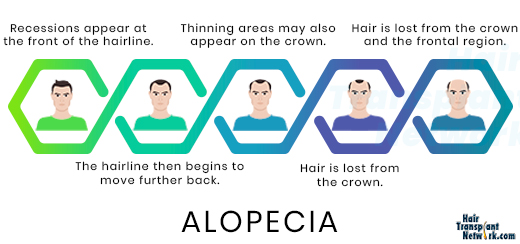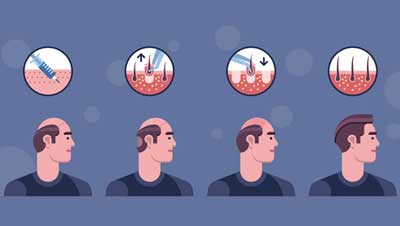Understanding Male Pattern Baldness and Hair Loss
Male pattern baldness, also known as androgenetic alopecia is the most common condition of thinning hair among men worldwide.
It can be identified by distinct patterns of thinning hair typically following what’s referred to as the Norwood-Hamilton scale of hair loss.
An early study found that nearly 30% of men show signs of baldness by age 35, while 50% show signs of thinning hair by the age of 55, however thinning hair can start as early as teenage years for some.

How Do You Know If You’re Suffering From Hair Loss?
Everyone has woken up to hair on their pillow or seen hair going down their shower drain, but how many individuals are suffering from men's hair loss? Unfortunately, it is not always easy to distinguish the difference between normal hair shedding and male pattern baldness. The two are not the same and can easily be confused, one for another. Battling androgenic alopecia should be done as soon as it has begun.
Tracking Hair Loss
In the beginning, hair loss can be very subtle, and individuals may be under the impression that they received a bad haircut or that stress may be causing temporary hair shedding. While it is true that stress can temporarily cause your hair to shed, this is usually resolved within a few months once the stressful situation subsides. However, individuals who continue to lose hair and overall density for a prolonged period of time may be suffering from androgenic alopecia (balding due to genetics).
Individuals are encouraged to take pictures of their hair daily, monthly and even yearly from various angles to compare recent pictures to older pictures. While this is not a fool proof, it is generally an easy way to find out whether male pattern baldness has continued or subsided. However, it is important to remember that men's hair loss may not always be visible to the naked eye.
How Does Hair Loss Occur?
The most common type of baldness is genetic. But what is the exact mechanism that triggers the male and female pattern balding gene?
Genetics
Androgenic alopecia (genetic hair loss) is a genetic condition that is inherited from either the mother's or father's side of the family. There is a common misconception that hair loss is inherited solely through the mother’s side of the family; this is not true. Individuals inherit genetic traits from both the mother and father's genes. Therefore, even if individuals on the mother's side of the family don’t experience hair loss, an individual can still inherit the genes from the father's side.
Generally, there is at least one person in the family that mirrors their own hair loss. The pattern and age are usually very similar as well. Individuals who think they may be suffering from male hair loss should take a look at their family history.
For men who are experiencing thinning hair, their follicles on the top of the head are genetically vulnerable to baldness. Over time, these genetically vulnerable follicles are acted upon by the hormone DHT. This hormone binds with the receptor sites of these vulnerable follicles and causes a miniaturization of the hair shaft and follicle over time.
This process of losing hair gradually breaks down the follicles' ability to grow healthy, thick hair. The result is Male Pattern Baldness.
Hormonal Changes
Male pattern baldness can be associated with 'Androgens', the male sex hormones that tend to play an important role in regulating the growth of hair. Hair follicles, as well as sebaceous glands contain a high level of an enzyme called 5-alpha reductase.
This enzyme is responsible for converting testosterone into dihydrotestosterone (DHT) through the blood stream. DHT is the main hormone responsible for causing androgenic alopecia (genetic hair loss) in both men and women.
Chronic Conditions
Baldness in men is sometimes associated with chronic conditions such as cancer, scalp infections, stress, anabolic steroids, thyroid disorders or other problems.
How Can Hair Restoration Doctors Help?
If you suffer from male hair loss, consult with a hair transplant doctor or dermatologist. Unfortunately, it may be so slow and subtle and may not be clearly visible, but that doesn't mean that it is not occurring. Most hair doctors carry high magnification glasses and cameras that can visibly detect miniaturization at the microscopic level. Most individuals will find that 5-10% of their hair are in the telogen (resting) phase at any given time. If there is over 25% of hair in telogen, there is a high indication of hair loss.
Additionally, physicians will review the individual’s family history to determine if there is already a similar, pre-existing pattern of hair loss. Age is also another factor that helps physicians determine if the individual is suffering from androgenic alopecia. It is normal for everyone's hair to reduce in overall density over time and with age, however, if this is occurring in young individuals, it is generally a sign of genetic loss of hair.
The Effects of Men's Hair Loss Are More Than Skin Deep
In 2018, a study was published in The Korean Dermatological Association and The Korean Society for Investigative Dermatology. A population-based cross-sectional survey of 503 patients with genetic hair loss (329 men, 174 women) was taken and various demographic data was collected. This included a family history of genetic hair loss, history of past treatment, self-perception and treatment willingness using structured questionnaires. The results were astounding.
The results showed 247 out of the 503 participants (49.1%) did not have a perception of hair loss and 262 out of 503 patients (52.1%) did not have treatment willingness in the future. The patients with a perception of balding, accurate information, and severe hair loss showed 1.745-fold, 1.700-fold, and 2.078-fold higher tendency of receiving treatment in the future.
The findings showed that patients with a perception of baldness and a greater understanding of androgenic alopecia tend to pursue treatment. This study essentially showed how those who suffer from baldness are willing to try treatments.
In 2017 a survey of just over 2,000 men, commissioned by Asda Pharmacy, showed the major psychological strain experienced when dealing with male hair loss. The results of the survey showed that 35% of the men reported turning to drugs and alcohol as a result. Another 38% said they struggled with depression due to their male pattern baldness, while 39% claimed to experience a lowered libido (sex drive). 1/3 of the men surveyed reported avoiding social activities, and almost 1/3 struggled with confidence issues. Lastly, 31% are already actively considering hair transplantation as a possible solution.
Male Pattern Baldness Can Be Reversed With The Right Treatment

Losing your hair is tough. We know because we’ve lived with thinning hair and baldness. We’ve felt the depression of watching our hair literally go down the drain, of hiding under a cap and avoiding too much of life. We’ve been there.
But many of us involved with this online community have learned how to stop hair loss by using legitimate hair regrowth treatments for men and visiting the right hair restoration doctors. Now we’re here to help you navigate the maze of options and find a hair loss solution, product or treatment that works for you.
The Steps to Stopping Hair Loss
Get to know your enemy
To overcome men's hair loss you first need to understand the causes. Then you can move on to stopping and reversing it.
As we’ve discussed, for most men who are losing their hair (95 percent), their baldness is genetic. It has nothing to do with wearing tight caps or combing too much or too little.
How vulnerable we are to hair fall or not is largely pre-programmed into our genes before birth. But our genetic fate can be altered by using an effective treatments; either non-invasive options like Propecia, or hair transplant surgery.
Non-Invasive Solutions for Male Hair Loss
According to the rule of decades nearly 50% of all men experience some form hair loss by the age of 50. However, most sufferers are fooled by catchy marketing phrases like "promote hair growth" and "all natural", but don’t fall for these deceptive advertisements. These 2 options for non-invasive treatment can provide the best results.
Rogaine (Minoxidil)
Rogaine (minoxidil) was originally used to treat blood pressure in the 1980's however, it was later discovered that one of the drugs side effects included hair growth. As a result, Rogaine was tested for use as a topical treatment for re-growing hair. The results were impressive enough for the FDA to approve it as a treatment option.
Rogaine is one of the only proven medications approved by the FDA to treat androgenic alopecia or other genetic hair loss. In addition, it is the only FDA approved treatment that will also work for female patterned hair loss.
Propecia (Finasteride)
Initially, the drug company Merck manufactured the drug Proscar; which was a 5 mg tablet of Finasteride that was used to treat Benign Prostatic Hyperplasia (BPH). Patients taking Proscar for BPH began to notice their hair loss stopped and, in some cases, even reversed after taking the medication. As a result, in 1997 the FDA approved 1mg of Finasteride as men's hair loss treatment and the drug company Merck would name the drug Propecia.
Currently, Propecia (finasteride) is the most effective drug on the market today with 66% of patients regrowing their hair after starting treatment and 83% of patients stopping their hair loss altogether. Unfortunately, women cannot take Propecia.
Surgical Options for Men's Hair Loss Treatment
We have all seen the pluggy "Barbie doll" and "corn row" hair transplants of the past. But today, most hair transplants go unnoticed because of the state-of-the-art surgical techniques being used by the world’s best surgeons. While non-invasive treatments may regrow some hair and stop the progression of men's hair loss and balding, the only way to truly regrow hair on a completely bald part of the scalp is through a hair transplant surgery.
Surgeons are now able to "dense pack" balding areas with as many as 40-60 follicular units per square centimetre and even more in some cases. To see how many follicular units it would take to restore your hair with hair transplant surgery, use our animated graft calculator.
Common Types of Hair Loss in Men and Their Treatment Options
There are many types of hair loss in men. Some of the common conditions are as below
Video: Different Forms Of Hair Loss
Involutional Alopecia
This is the most common type of baldness in men, where the hair starts to thin naturally with age. Most hair follicles go into resting phase while remaining hair becomes short. Involutional alopecia is an overall thinning of the scalp that occurs with age, as more and more hairs enter the telogen (resting) phase. The hair’s life cycle become shorter and shorter, giving an appearance of thinning or balding.
Causes: There are three phases to a hair follicles life cycle. The anagen (growth) phase, catagen (transitional) phase, and telogen (resting) phase. When a significant number of hairs enters the telogen (resting) phase all at once the scalp will appear thinner and less dense.
Symptoms: There are no symptoms of involutional alopecia, other than the visual appearance of thinning. This form of alopecia is age-related and occurs in older people.
Treatments: There is no real treatment for involutional alopecia, but some may benefit from using Rogaine (minoxidil) a topical vasodilator that has been shown to extend the anagen (growth) phase of a hair follicles life cycle.
Androgenic Alopecia
This is a genetic condition that is characterized by the gradual disappearance of the hairline from the frontal scalp and/or the crown as early as teen age.
Causes: Both men and women produce testosterone. Hair follicles, as well as sebaceous glands, contain high levels of an enzyme called 5-alpha-reductase. This enzyme converts testosterone in to dihydrotestosterone (DHT) via the blood. DHT is the main catalyst for androgenic alopecia or genetic hair loss in both men and women.
Over time, genetically susceptible follicles are weakened by DHT. This hormone binds with the receptor sites of these vulnerable follicles and causes the hair follicles to shrink over time until they no longer grow.
Symptoms: There is no physical ailment associated with genetic hair loss, but some sufferers complain of scalp inflammation and itching. The first sign of balding typically appears in the hairline and gradually extend in to the crown (vertex).
However, men's hair loss and the degree of thinning may differ from person to person and some individuals do not lose any hair besides minor temple recession, while others go completely bald on top.
Treatments: There are millions of lotions, potions and pills that are so-called treatments for androgenic alopecia. However, the vast majority of these products are bogus and do not work. Truthfully, there are only two medications that have been approved by the FDA to stop the progression of genetic hair loss: Propecia (finasteride) and Rogaine (minoxidil). However, those suffering have been combining Nizoral - Aketoconazole shampoo, which is an anti-fungal shampoo used to treat dandruff.
There have been some clinical studies that have shown that Nizoral may be somewhat effective in treating men's hair loss. The combination of finasteride, minoxidil and Nizoral is often referred to as the “big 3”. That said, the only way to truly regrow hair on a bald scalp is through hair transplant surgery.
This type of hair loss is caused by inflammatory skin conditions such as folliculitis, cellulitis, and acne that destroys the ability of hair to regenerate.
Scarring Alopecia
Causes: This type of hair loss is caused by dissecting cellulitis, eosinophilic pustular folliculitis, follicular degeneration syndrome (previously called "hot comb" alopecia), folliculitis decalvans, lichen planopilaris, as well as other inflammatory skin conditions.
Symptoms: Some suffering from scarring alopecia may have smooth and clean affected area. However, some may suffer from redness, scaling, increased or decreased pigmentation, or puss-filled blisters. Many complain of inflammation, itching, and burning. However, the pain usually goes away.
Treatments: Scarring alopecia’s can be treated with corticosteroids, topical ointments, as well as antimalarial and isotretinoin drugs. In severe cases, patients may be eligible for hair transplant surgery once the condition has been treated and stabilized.
Alopecia Areata

This type of hair loss starts suddenly in children and young adults and may result in complete baldness. The hair returns within a few years for most people. Total loss of hair due to this condition is often referred to as Alopecia Universalis or Alopecia Totalis.
Causes: The specific cause for alopecia areata is unknown; however it is thought to be an autoimmune disorder that causes the body's immune system to attack its own follicles. A biopsy of the affected skin may show immune lymphocytes (white cells) in the hair bulb of the hair follicles. Alopecia areata has been associated with other underlying medical conditions such as thyroid disorders, vitiligo, lupus, rheumatoid arthritis and ulcerative colitis. Therefore, it is important to rule out any underlying medical causes first.
Symptoms: The most obvious and common symptom of alopecia areata is one or more spots of baldness on the scalp, each spot about the size of a quarter. In rare cases larger areas of the scalp will have thinning otherwise known as diffuse alopecia areata. In extreme cases, all hair follicles on the head will thin and bald as a result of the condition.
Treatment: Unfortunately, there is no cure for alopecia areata and current treatments, while somewhat effective, offer limited success. The current treatments include; steroid injections, topical corticosteroids, topical immunotherapy, Rogaine (minoxidil) and ultra violet therapy.
In most cases, even without treatment the hair follicles regrow on their own. In rare instances, the hair loss may be permanent. Hair transplant surgery may be an option to restore hair to the bald area. However, there's no guarantee that new bald patches won’t appear in the transplanted area sometime later down the road.
Telogen Effluvium
Telogen Effluvium or shock loss is a form of short-term men's hair loss that generally occurs after stress, trauma or a surgical procedure. This temporary balding is predominantly contained on the top of the scalp.
Causes: Individuals who experience intense stress for a prolonged period of time can often succumb to telogen effluvium or shock loss. A poor diet or vitamin deficiencies can also contribute to telogen effluvium. In fact, the body requires key nutrients to produce hair such as protein, iron, B-vitamins and zinc. In addition, hair restoration surgery can often lead to telogen effluvium or shock loss. Surgical trauma occurs because hairs are implanted near surrounding native hairs. This causes trauma to the surrounding follicles which in turn causes telogen effluvium.
Symptoms: Chronic hair shedding for an extended period of time lasting up to 6 months is a common symptom. Individuals suffering notice a diffused thinning spanning across their entire scalp.
Treatment: Generally, telogen effluvium is a temporary condition which resolves on its own. However, certain medical conditions including autoimmune diseases and thyroid conditions can lead to it. Therefore, it is important to speak to a medical professional to rule out any underlying health conditions.
Diffused Patterned Alopecia (DPA)
Diffused Patterned Alopecia (DPA) is a type of androgenic alopecia or genetic hair loss. Unlike typical male pattern baldness, diffused patterned alopecia does not follow the Norwood scale or Ludwig scale. Rather, it is categorized as a diffused thinning over the entire scalp.
Causes: DPA can be difficult to diagnose especially in its early stages and is often misdiagnosed as Diffused Unpatterned Alopecia (DUPA). While both conditions are characterized as diffused thinning, DUPA sufferers lack the stable permanent zone necessary for surgical hair restoration.
Dermatologists and hair restoration surgeons are able to diagnose DPA by comparing the top, sides, and back of the scalp by using high magnification instruments that can detect miniaturized follicles. If the top of the scalp contains miniaturization and the sides and back of the scalp do not, then the surgeon is able to ascertain whether or not the patient is suffering from DPA or DUPA.
Symptoms: No physical symptoms really occur. However, the sudden onset of a massive hair shed can be associated with DPA. This occurs because all of the hairs on the top of the scalp are being affected by DHT and thus, the hair follicles anagen (growth) phase is being shortened.
Treatment: DPA responds well to both Propecia and Rogaine. Both drugs work synergistically together, and both can stop the progression of men's hair loss and even regrow hair in some patients. Surgical hair restoration is also an option for many men and even women with DPA.
Diffused Unpatterned Alopecia (DPA)
DUPA is a form of genetic hair loss that can affect any part of the scalp and can affect both men and women and is generally sporadic with no clear pattern.
Causes: Diffused Unpatterned Alopecia (DUPA) is a subtype of androgenic alopecia. Testosterone converts in to Dihydrotestosterone and is the main catalyst for genetic hair loss. Hair follicles, as well as the sebaceous glands, contain high levels of an enzyme called 5-alpha-reductase which converts testosterone into DHT, via the blood. The difference between male pattern and female pattern hair loss is that DUPA does not follow any pattern. Therefore, the back and sides of the scalp may be susceptible to thinning.
Symptoms: The most common symptom of diffused unpatterned alopecia is a diffuse thinning over the entire scalp. Unlike Diffused Patterned Alopecia (DPA), DUPA lacks the stable permanent zone associated with other forms of alopecia. DUPA is defined as a general decrease in the density of hair without any definite pattern.
Treatment: As a subtype of androgenic alopecia, it’s typically treated with the same medications as DPA.
Learn From and Correspond With Actual Patients and Doctors
- Visit our popular Discussion Forum and learn about hair loss treatment, results, and patient-reviewed hair transplant surgeons.
- Consult with patients and qualified hair restoration physicians by viewing our Patient Stories that document their recovery. These patients have volunteered to share their story and are often willing to correspond by email.
- Visit our Hair Loss Q & A Blog and post your questions, and read dozens of posts on a wide range of hair restoration topics.
We’re Here to Help You Reverse Your Hair Loss

Our popular discussion forum hosts thousands of posts by men and women who have suffered from losing their hair. Many of them still visit our forum to share advice and offer support. It’s all about sharing credible hair loss information and acting on it.
Find a prescreened hair transplant surgeon in your area.
Learn how hair restoration surgery can restore your hair for a lifetime
Together, We Can Fight Men's Hair Loss!
Remedies and treatment have advanced dramatically over the past ten years. Propecia and Rogaine can slow or even stop balding, while hair transplants can restore hair that was lost.
Our recommended surgeons are highly qualified, experienced and use start-of art equipment and cutting-edge technologies for the best clinical outcome.
Each hair restoration surgeon recommended on the Hair Transplant Network is committed to providing 100% safe treatment options for individuals suffering from different types of hair loss and offer customized men's hair loss treatment to fit into your budget.
Consult for free with one of our prescreened physicians and find the best possible solution for your hair problems.







